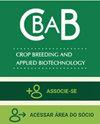Initiation of breeding programs for three species of Corymbia: Introduction and provenances study
IF 1.1
4区 农林科学
Q2 Agricultural and Biological Sciences
引用次数: 2
Abstract
The objective of this study was to establish populations to start the breeding program of three species of Corymbia that are not widely planted in Brazil yet. To this end, basic density, bark content and growth of seedlots/provenances were evaluated three years after planting. The experiments consisted of 14 treatments for Corymbia citriodora subsp. variegata (CCV), 15 for C. maculata (CM), and five for C. henryi (CH). The species exhibited high survival, indicating adaptation to the Cwa climate while average coefficients of determination of seedlots exhibited intermediate values. The CCV from the Richmond Range (28o 55’ S) exhibited the highest productivity. The mean annual increment was low (22 to 26 m3ha-1), but the basic density (573 to 613 kg m-3) was high compared to the standard for eucalypts in Brazil. The bark content was close to 15% and varied between and within species.三种山茱萸育种计划的启动:引种和种源研究
本研究的目的是建立种群,以启动三种在巴西尚未广泛种植的Corymbia的育种计划。为此,在种植3年后对种源的基本密度、树皮含量和生长情况进行了评价。试验共设14个处理。杂交种(CCV),斑蝥(CM) 15种,亨利(CH) 5种。该物种表现出较高的成活率,表明其对中国气候的适应,而种子区平均测定系数则表现为中等值。来自Richmond Range(28 ~ 55′S)的CCV表现出最高的生产力。年平均增量较低(22 ~ 26 m3ha-1),但基本密度(573 ~ 613 kg m-3)高于巴西桉树的标准。树皮含量接近15%,种间和种内差异较大。
本文章由计算机程序翻译,如有差异,请以英文原文为准。
求助全文
约1分钟内获得全文
求助全文
来源期刊
CiteScore
2.40
自引率
13.30%
发文量
25
审稿时长
6-12 weeks
期刊介绍:
The CBAB – CROP BREEDING AND APPLIED BIOTECHNOLOGY (ISSN 1984-7033) – is the official quarterly journal of the Brazilian Society of Plant Breeding, abbreviated CROP BREED APPL BIOTECHNOL.
It publishes original scientific articles, which contribute to the scientific and technological development of plant breeding and agriculture. Articles should be to do with basic and applied research on improvement of perennial and annual plants, within the fields of genetics, conservation of germplasm, biotechnology, genomics, cytogenetics, experimental statistics, seeds, food quality, biotic and abiotic stress, and correlated areas. The article must be unpublished. Simultaneous submitting to another periodical is ruled out. Authors are held solely responsible for the opinions and ideas expressed, which do not necessarily reflect the view of the Editorial board. However, the Editorial board reserves the right to suggest or ask for any modifications required. The journal adopts the Ithenticate software for identification of plagiarism. Complete or partial reproduction of articles is permitted, provided the source is cited. All content of the journal, except where identified, is licensed under a Creative Commons attribution-type BY. All articles are published free of charge. This is an open access journal.

 求助内容:
求助内容: 应助结果提醒方式:
应助结果提醒方式:


